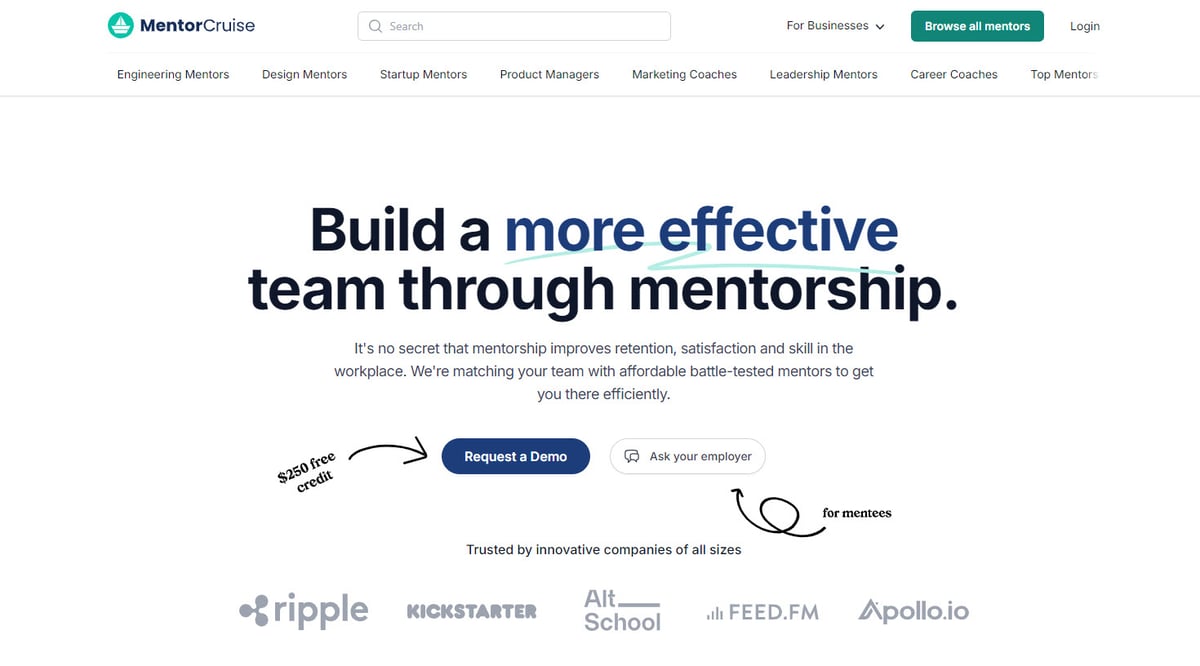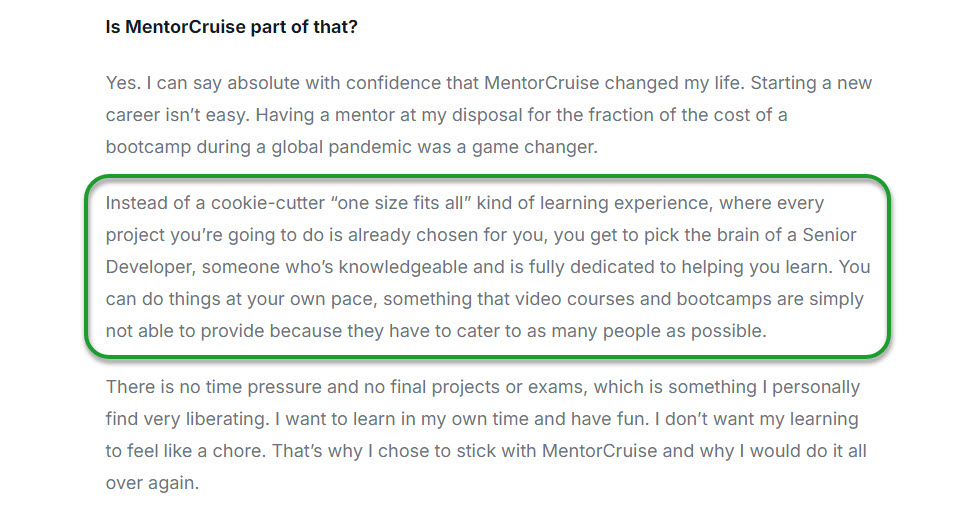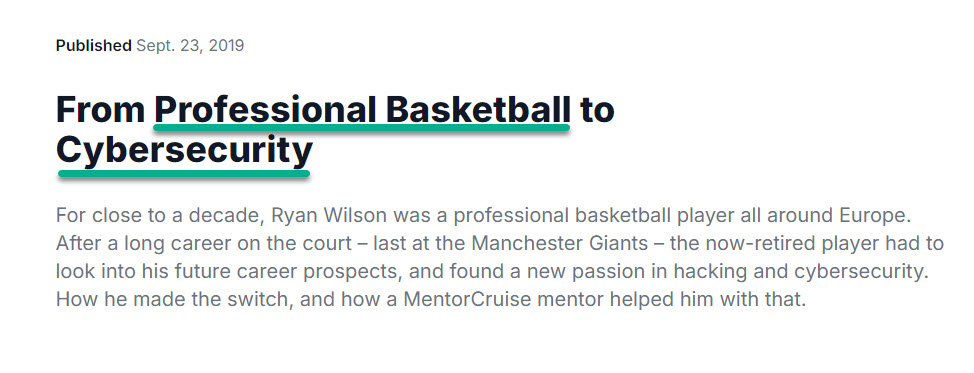Employee training is the key to building a strong, engaged team. If you’re an HR professional or any other manager, you always need to consider the best training methods to keep pushing your team forward.
This article dives into ten cutting-edge training methods for employees. You’ll discover a variety of techniques, from mentorship programs to peer-to-peer learning, each designed to boost employee productivity and strengthen your workforce. Let’s get started.
At MentorCruise, we have successfully helped brands enrich their workforce with enhanced skills and adaptability through our team coaching and mentorship offerings. Our mentors are instrumental in these achievements.
For example, our mentors have helped people like Ryan Wilson and Joris Zierold advance in their careers. Despite having little to no experience, both of them were able to get the training they needed to get hired for their desired roles.
Employee training methods are systematic. They are used to improve the skills, knowledge, and competencies of employees in an organization. By implementing them, you equip staff to perform their jobs effectively and prepare for future roles.
Training methods for employees can vary substantially. They range from hands-on workshops to online courses, and cover everything from real-world experiences to interactive group activities. Each method offers unique advantages and can be customized to fit diverse learning preferences and professional needs.
In the following sections, we will break down these training methods to see how you apply them strategically to foster a thriving, skilled team.
Embracing effective training methods for employees can transform your organization. Here’s how:
Each of these points highlights the transformative potential of effective training methods on employee performance and organizational success. By focusing on these areas, companies can create a more dynamic, committed, and skilled workforce.
Choosing the right training methods for employees is crucial for enhancing their skills and engagement. Here's what to consider to ensure your training programs are effective and align with your organizational goals:
Each employee has a unique way of learning, which can greatly impact how effectively they absorb training material. For instance, visual learners benefit from diagrams and videos. Auditory learners prefer lectures or discussions. Kinesthetic learners excel with hands-on activities and real-world simulations.
By identifying these preferences through surveys or assessments before designing your training program, you can tailor content to match the learning styles of your team. This ensures that each member gains the most from the training sessions.
The training you provide should have a clear purpose aligned with the broader objectives of your company. For example, if the goal is to improve customer satisfaction, training might focus on communication skills, understanding customer needs, and effective problem-solving.
Set specific, measurable, achievable, relevant, and time-bound (SMART) goals for your training programs. This way, you can ensure that each session directly serves your business's aims. This makes the investment in training more justifiable and likely to produce results.
Effective training doesn’t have to drain your resources, but it does require thoughtful consideration of what you can afford in terms of money, time, and tools.
For smaller companies, this might mean leveraging cost-effective online courses that employees can complete at their own pace. For larger organizations, it could involve a more structured method like workshops, seminars, or team mentorship (like the one MentorCruise provides).

The key is to balance your resource allocation with the potential return on investment from enhanced employee performance and satisfaction. This can lead to greater overall productivity and profitability.
As your company grows, your training programs should also adapt to accommodate more employees and potentially more diverse needs. Mentorship programs, in particular, offer a flexible and scalable option for training that can grow with your organization.
By connecting less experienced employees with seasoned professionals, mentorship can be easily scaled up to include more pairs as your workforce expands. This method helps personalized learning. It also reinforces company culture and knowledge sharing. This happens across different levels and departments.
Below, we highlight ten proven training methods that you can adopt to equip your employees with the skills they need to function effectively across various roles. Let's dive right in.
Mentorship programs are structured relationships where experienced professionals guide less experienced employees through personal interaction and support. This form of training aims to transfer knowledge, enhance skills, and build professional networks. It provides mentees with insights and advice that are not readily available through traditional training methods.
At MentorCruise, we specialize in connecting mentees with industry leaders tailored to their specific career paths and goals. This one-on-one guidance accelerates professional development and provides a safe space for addressing individual challenges and aspirations.
For instance, imagine a young software developer struggling with advanced coding techniques. Through MentorCruise, they can connect with a seasoned developer who can guide them through complex problem-solving scenarios.
Daniel Carlman used this exact method to accelerate his career growth in tech. Although he came from a finance background, Daniel quickly grew his tech prowess when he connected with Farzad Yousefzadeh, a top mentor on MentorCruise.
Here’s an excerpt from Daniel’s success story, highlighting MentorCruise’s contribution to it:

You can also expand the skills of your employees through effective mentorships. Ready to see if it’s a right fit for your brand? Check out MentorCruise’s mentorship offerings for teams and request a free demo today.
Interactive workshops are another highly effective training method for employees, promoting active participation and immediate application of new skills. These workshops involve structured group activities that encourage hands-on learning and collaborative problem-solving.
Workshops foster an interactive environment, making learning fun while building teamwork and communication skills among employees. The immediate application of learned concepts ensures that employees can see the relevance of their training.
eLearning allows learners to access training materials online from anywhere at any time, making it possible to integrate learning into their daily routines without disrupting workflow.
For example, an eLearning course on product design could include interactive tutorials, quizzes, and video lectures. Employees can engage with them at their convenience. This method supports self-directed learning. Employees are motivated to explore topics more deeply. They do so based on their interests and job requirements.
Also, eLearning platforms often offer tracking and reporting tools. These tools help managers monitor progress and gauge how well training works. This data-driven method of employee development ensures that the training is both accessible and impactful.
Simulation and role-playing are dynamic training methods. They simulate real challenges and scenarios faced by employees. These methods provide a safe environment for employees to practice skills, make decisions, and see the consequences of their actions without the risks that might come if they were to make these mistakes in the real world.
Take, for example, a customer service training simulation where employees role-play both the customer and the service provider roles. This type of training allows them to experience both perspectives to develop their communication skills.
Simulations can also be technical, such as virtual reality setups that mimic actual working environments for hazardous jobs. This kind of immersive experience is particularly valuable in industries where mistakes can be costly or dangerous. It provides employees with the confidence and competence they need to perform their tasks.
Cross-functional training is an innovative training method for employees that broadens their skills across different areas of the business. It enhances versatility among team members and fosters a deeper understanding of the company as a whole.
For example, a marketing employee benefiting from a stint in the sales department can learn customer engagement strategies and sales processes directly from experienced colleagues. This practical immersion helps employees understand how their roles impact other business areas.
MentorCruise plays a crucial role in this context. It facilitates connections with mentors from diverse functional backgrounds. These mentors offer tailored guidance, complementing the hands-on experience from cross-functional training.
MentorCruise has successfully helped individuals like Ryan Wilson, who broke into cybersecurity after three months of dedicated mentorship, navigate new career paths with zero prior experience.

By integrating cross-functional training and augmenting it with expert mentorship from MentorCruise, your team’s flexibility and responsiveness to business needs can significantly improve.
Team-building exercises are a vital training method for employees that foster collaboration, improve communication, and enhance workplace culture. These activities are designed to break down barriers in the workplace and encourage a more cohesive team environment.
For example, a simple team-building activity could involve a group challenge. It would require employees to work together to solve a puzzle or complete a task within a time limit. These exercises help you teach the value of teamwork, creative thinking, and strategic planning.
By incorporating team-building exercises into your training methods, you can help create a more united team that is better equipped to handle professional challenges together. This method improves interpersonal relationships and boosts overall team performance and job satisfaction.
Industry conferences and seminars are effective training for employees. They expose them to the latest trends, technologies, and thought leaders in their field. These events provide a platform for learning from experts and peers outside the immediate workplace, which can spark innovation and new ideas.
For example, if you’re working with a marketing team, a conference like Growth Marketing Summit can be quite beneficial.

Focused on growth marketing, the conference features a lineup of world-class speakers discussing data-driven marketing solutions. It's particularly valuable for digital marketing professionals looking to leverage analytics and user feedback to scale their operations efficiently.
In addition to enhancing professional knowledge, industry events expand networking opportunities, connecting employees with potential collaborators and industry contacts.
On-the-job training is a hands-on method that allows employees to learn by directly performing their job roles. It’s highly effective because it integrates learning with actual work tasks, providing immediate opportunities to apply new skills in real-world scenarios.
On-the-job training is often complemented by shadowing or coaching from more experienced colleagues, which can accelerate learning and ensure that proper techniques are followed.
Leadership development programs are a strategic training method for employees aimed at cultivating future leaders within an organization. These programs are structured to develop critical leadership skills such as decision-making, strategic thinking, and effective communication.
For instance, a company might create a series of workshops and modules. These would include mentorship from senior leaders, leadership theory, and practical leadership tasks. Give participants a chance to lead a team. For instance, managing a departmental budget.
By investing in leadership development, you prepare your entire organization for change. The employee training method establishes a pipeline of skilled leaders who are well-equipped to steer the company forward in alignment with its goals.
Peer-to-peer learning is a collaborative training method that leverages the knowledge and skills within your own workforce to educate and enhance the capabilities of your team. It involves employees teaching and learning from their colleagues, leading to a more engaged and interconnected workplace.
For example, a tech company might organize regular "lunch and learn" sessions where employees present on topics they are knowledgeable about or have recently mastered. This could range from new coding techniques to project management tools.
Peer-to-peer learning is particularly effective because it builds a supportive learning community within the workplace. This training method enriches the team’s skills.
Empowering your team through effective training can transform your team into a well-oiled machine. By focusing on innovative and impactful training methods like mentorship programs, you not only boost your team's efficiency and engagement but also significantly enrich their personal and professional lives.
MentorCruise stands out by offering specialized mentorship and coaching that's tailored to meet the unique needs of your team. Through our platform, your employees can connect with industry leaders and gain relevant and transformative insights.
Ready to elevate your team's potential? Check out MentorCruise today and explore our comprehensive mentorship and coaching solutions designed for growth-focused teams like yours.
Find out if MentorCruise is a good fit for you – fast, free, and no pressure.
Tell us about your goals
See how mentorship compares to other options
Preview your first month
